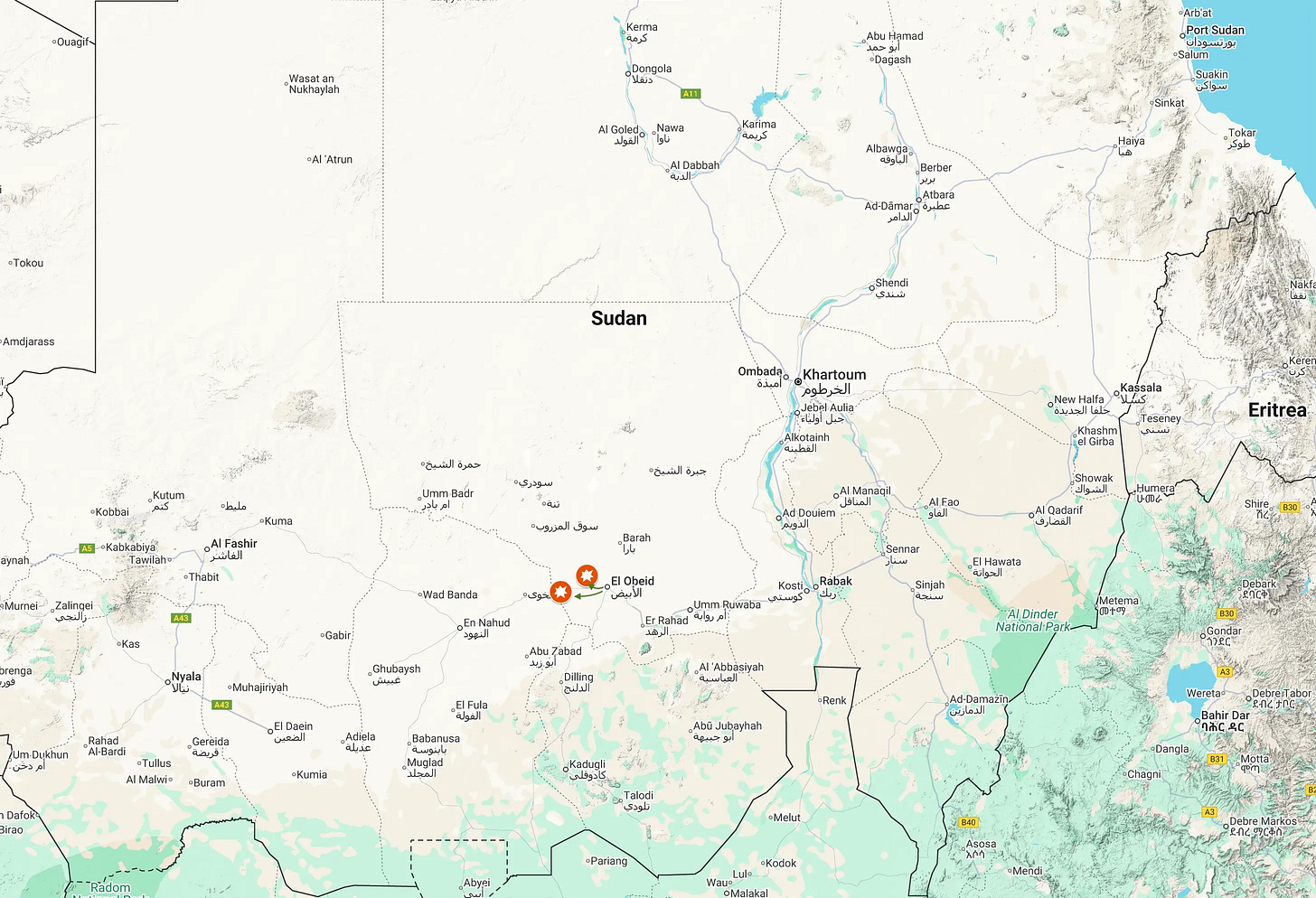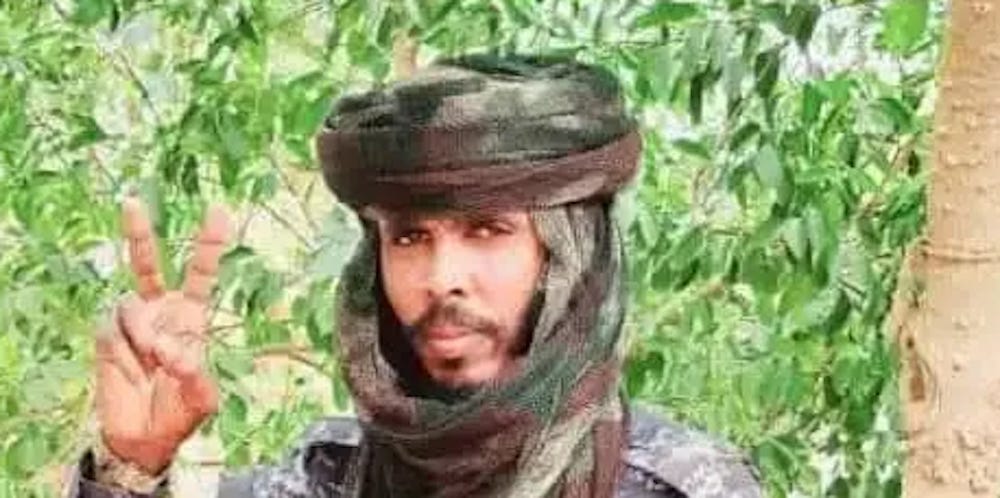Fighting west of El Obeid as army breaks through to Umm Sumaima
RSF units retreat toward West Kordofan after suffering losses
The Sudanese Armed Forces (SAF) and allied Darfur armed groups have mounted one of their largest offensives in weeks, regaining control of Umm Sumaima in North Kordofan, along the main road to West Kordofan and Darfur.
Sudan’s civil war, now in its third year, has moved out of the country’s Nile Valley heartland, allowing tens of thousands of displaced civilians to return to their homes. But the conflict remains one of the deadliest in the world, as fighting continues on the plains of Kordofan and Darfur, arid western regions that are the homeland of the Rapid Support Forces (RSF), a regional paramilitary that mutinied in 2023.
The latest fighting erupted at dawn on Friday and continued Saturday, beginning with an assault on Al-A’yara, a village west of El Obeid. SAF ground troops, supported by allied units from the Darfuri Joint Force (JSAFM), overran RSF defensive positions, destroying several armored and logistics vehicles and forcing RSF fighters to retreat westward. From there, the army pushed through to Abu Qa’ud before advancing into Umm Sumaima, a town along the border with West Kordofan, where the RSF control nearly all territory except for Babanusa and Heglig.
Field footage verified by Sudan War Monitor showed rows of captured RSF soldiers, alongside destroyed and abandoned combat vehicles. Amid the wreckage was a STREIT Group-manufactured armored logistics truck, a vehicle type that has become a staple of RSF convoys, often supplied through networks linked to the United Arab Emirates.
In this video, a UAE-manufactured truck is seen burning reportedly after being hit with an RPG. Sudan War Monitor was unable to geolocate the footage, but it is estimated to have been filmed somewhere between Umm Sumaima and Abu Qa’ud.
The capture of such equipment underscores the intensity of the fighting and the determination of the RSF to defend the road between El Obeid and An-Nahud, in order to prevent a SAF advance into West Kordofan State. According to multiple sources, the RSF suffered heavy casualties, including losses among its senior ranks. Colonel Al-Qaws Adam, commander of RSF Group 307, was killed at Abu Qa’ud. His unit was one of the formations deployed on the Umm Sumaima front.
Before SAF and JSAMF fighters could consolidate control over Umm Sumaima, the RSF launched a fierce counterattack from their bases in West Kordofan. By Friday evening, RSF patrols had re-entered the town, briefly forcing the army to retreat. Locals reported heavy exchanges of artillery and small arms fire across the town’s eastern approaches. However, by Saturday morning, SAF and its allies surged back, re-establishing control after dislodging the RSF.
After this fighting, a spokesman for the Joint Forces was filmed at the eastern entrance of Umm Sumaima, dismissing RSF claims of continued presence inside the town. The footage, geolocated by Sudan War Monitor, placed him at a fuel station one kilometer east of the town center, along the El-Obeid–Khuwei–An-Nahud highway. This location is notable as it lies just west of a previously filmed RSF reconnaissance patrol two kilometers east of the town center (video below), suggesting back-and-forth advances and contested approaches until Saturday’s recapture.
While the offensive west of El-Obeid met with some success, SAF’s attempt to expand northward toward Jebel Abu Sinun stalled. Army and JSAMF units launched an assault into the hilly terrain but encountered stiff resistance from entrenched RSF fighters. By Friday morning, the SAF had been forced to withdraw to their staging area in Karbab, the village from which the attack was launched.
This front has since fallen quiet, with no renewed SAF attempts to dislodge RSF elements there. The setback highlights the challenges the Sudanese army faces when advancing into RSF-held terrain beyond the immediate reach of supply lines from El-Obeid. Unlike Umm Sumaima, where SAF benefitted from proximity to highways and allied forces, the northern front exposed vulnerabilities that the RSF have exploited to maintain a presence in North Kordofan, despite losing control of the urban areas.
The Sudanese military offensive west of El-Obeid came just a week after RSF fighters launched a push from Al-A’yara, advancing to the outskirts of the state capital El Obeid. Footage from that assault showed RSF units closing to within striking distance of El Obeid’s defensive perimeter, sparking panic among civilians and forcing SAF to rush reinforcements from surrounding areas.
That incursion underscored the RSF’s continuing ability to operate in North Kordofan and threaten SAF supply lines, hindering the army’s westward advance. The SAF latest offensive is widely interpreted as an attempt to push the RSF farther away from El Obeid’s approaches, better securing the state capital and key supply lines.
Both sides rushed to claim victories during the latest fighting. RSF-affiliated channels circulated videos insisting their forces still controlled Umm Sumaima as late as Friday night. By contrast, Sudanese military propagandists released clips showing captured RSF vehicles and prisoners. Sudan War Monitor was able to geolocate and verify several of these. The number of RSF prisoners taken remains unclear, but eyewitnesses reported “a large number” of captured fighters being transported eastward toward El-Obeid. For SAF, showcasing prisoners and captured vehicles has become a propaganda tool aimed at shoring up morale among its supporters.
Fighting in North Darfur capital
The renewed clashes in North Kordofan come as the RSF tightens its siege of El-Fasher, North Darfur. Since late 2023, the army and allied Joint Force have held out under siege conditions, but recent RSF advances have brought their fighters within a few hundred meters of the 6th Infantry Division headquarters in central El Fasher.
Sudan War Monitor geolocated footage of RSF soldiers at the armored corps offices in El-Fasher, just south of the former UNAMID base that now houses the Joint Force headquarters. That base was briefly overrun by RSF units last week before the army and allied fighters forced them out. The RSF’s proximity to both the division HQ and Joint Force hub raises the specter of El-Fasher’s imminent capture—an outcome that would eliminate the Sudanese army’s last major foothold in Darfur.
The SAF’s offensive west of El-Obeid may serve a broader strategic purpose of diverting RSF manpower and resources from the El-Fasher siege and making progress toward the eventual relief of El-Fasher.
Hundreds of civilians have died in El Fasher due to shelling and stray bullets, while many others have starved to death or died of treatable illnesses due to the collapse of the healthcare system, following numerous attacks on hospitals and clinics.
Al-Burhan lands in El-Obeid after symbolic stop in Bara
The Sudanese army commander-in-chief, General Abdel Fattah al-Burhan, arrived in North Kordofan on a visit that carries heavier weight than his previous appearance in the state. He flew by helicopter from Khartoum, landing first in Bara—which the SAF recently recaptured—before proceeding to El Obeid, the state capital and the army’s main base of operations in the region.
Although Burhan visited Umm Ruwaba in February, a day after the Sudanese army captured it from the RSF, he had never set foot in El Obeid or Bara since the outbreak of the war. His presence in these two towns now underlines the army’s push to consolidate its grip over North Kordofan.
The choice of Bara was meant to celebrate a recent SAF victory. The town, once under RSF control, was retaken by the army earlier this month after heavy clashes. Its recapture marked a turning point on the El-Obeid front, helping secure the road between El Obeid and Sudan’s largest city, Omdurman. Burhan was welcomed by crowds of residents in both Bara and El-Obeid, a reception the army frames as evidence of civilian support against the RSF.
Burhan’s appearance also served a morale function for the rank-and-file. Soldiers on the El-Obeid front have been under constant pressure from RSF attacks, and the sight of the army chief visiting forward positions was intended to reinforce their resolve.
Videos
In this video, a member of the Joint Force of former Darfur rebels films himself to debunks RSF claims that they have regained control of the Umm Sumaima. “Soon we will film live from Al Khowei, and after that from An-Nahud,” he says, indicating the forces’ intention to continue their western advance. Sudan War Monitor geolocated this video to this location: 13° 7’13.68”N 29°37’35.10”E.
In this video, members of the Joint Force appear driving towards Umm Sumaima on their first capture of the town on Friday morning. This video was geolocated by Sudan War Monitor to this location: 13° 7’29.63”N 29°41’25.22”E.
In this video, SAF and allied soldiers gather around a vehicle that rammed into an RSF technical during clashes.
In this video, an RSF captive is given water while seated in a vehicle awaiting transfer to El-Obeid.
In this video, RSF soldiers are seen driving to the western entrance of Umm Sumaima, facing eastward into the town and claiming there was no presence of SAF or Joint Force troops. The footage is geolocated to this location: 13° 7’19.72”N 29°33’42.42”E.
RSF soldiers are seen operating at the western entrance of Umm Sumaima, facing eastward into the town and claiming there was no presence of SAF or Joint Forces. It is geolocated to 13°07’23.44”N, 29°40’40.31”E.




